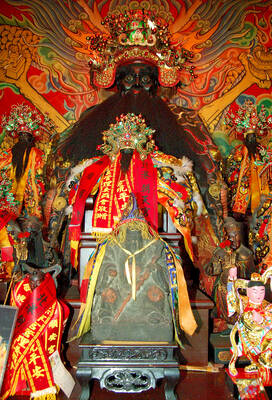If the world is to see its first hot war between two nuclear superpowers in the 21st century, its principal cause will likely be a small democracy of 23 million people. Or so argue Richard Bush and Michael O’Hanlon in their timely A War Like No Other.
Bush, a former director at the American Institute in Taiwan and current director of the Center for Northeast Asian Studies at the Brookings Institution in Washington, and O’Hanlon, a senior military analyst at Brookings, use their considerable knowledge in the fields of diplomacy and defense to show how the longstanding political dispute between Taipei and Beijing over Taiwan’s sovereignty could escalate to devastating effect and why world leaders should do everything in their power to avoid this contingency from becoming reality.
In commandingly clear prose and avoiding overly technical terminology, the authors explain why the decades-old US policy of mutual deterrence against Beijing’s hard-line “one China” stance and Taipei’s desire for sovereignty has worked and why future US administrations should continue to abide by this guiding principle. By opposing unilateral moves by Taipei to break the status quo — such as the declaration of a Taiwan Republic — while providing assurances, as stipulated in the Taiwan Relations Act (TRA), that the US would help Taiwan defend itself against an unprovoked Chinese military attack, Washington’s strategy has been to create space and buy time so that leaders on both sides of the Strait can resolve the conflict peacefully.
Published one year before the election of Ma Ying-jeou (馬英九) to the presidency and the Chinese Nationalist Party’s (KMT) victory in the legislative elections, one can nevertheless imagine the author’s sigh of relief at Ma’s election and his peace initiative, which would seem to confirm the wisdom of Washington’s longstanding policies on the Taiwan Strait. In this vein, the authors also make no effort to conceal their assessment of the administration of former president Chen Shui-bian (陳水扁) as having been “provocative,” “unreasonable” and taking unnecessary risks. Still, Bush and O’Hanlon helpfully point out that Beijing, having no substantial experience of democracy, is bound to misinterpret political developments in Taiwan, which could precipitate conflict. As such, one conflict-preventing measure the authors propose is for Washington to ensure that Beijing is able to “distinguish actions that the island’s politicians take for political gain and those that reflect policy intentions” as well as to impress upon the Chinese that Taiwanese are not necessarily opposed to all forms of unification.
Another important point the authors make is that the leadership in Taipei tends to assume rationality in Beijing regarding the Taiwan question, which could prompt the former to act “recklessly” — codeword for a move toward independence. Either as the result of misinterpreted signals or actual “provocation” by Taipei, China could feel compelled to abandon diplomacy and apply military pressure on Taiwan. Such action would involve a variety of scenarios, from a naval blockade to limited missile strikes to amphibious invasion, used separately, incrementally, or in combination.
Despite the authors’ assertion that war in the Taiwan Strait remains unlikely given what the participants stand to lose in terms of economic loss and casualties, there is a small chance that the Chinese leadership could think that war against Taiwan — or even against the US — is winnable, which could make conflict likelier.
Regarding Taiwan’s or the US’ ability to counter a Chinese attack, Bush and O’Hanlon are optimists, concluding that with the People’s Liberation Army (PLA) lacking three critical determinants for a successful amphibious assault — air superiority, initial troop/firepower superiority at point of attack, and reinforcement advantage at point of attack — added to hardened targets throughout Taiwan, an invasion would be prohibitively costly, if not impossible. Other analysts, including William S. Murray, an associate professor at the US Naval War College, are less optimistic and counter that the optimistic view, including the one O’Hanlon has held for years, fails to take into account the leaps made by the PLA in terms of modernization and accuracy.
Regardless of whether one sides with O’Hanlon or Murray on this issue — and admittedly Bush and O’Hanlon’s position appears to be slightly overoptimistic — the likeliest scenario of a Chinese attack remains the blockade, which Taiwan’s growing economic dependence on China has turned into a tempting, and possibly quite effective, weapon. As the TRA refers to such a contingency as a “threat to peace and security of the Western Pacific and of grave concern to the United States,” an economic embargo against Taiwan would likely prompt a response from the US military, which could be required to ensure safe passage for Taiwanese and international ships entering the Taiwan Strait.
Once the PLA and the US military are brought within proximity to each other, with a third party — Taiwan — beyond the control of both but capable of inflaming the situation, the likelihood of escalation becomes dangerously real, the authors argue. Errors could be committed that, unlike the peacetime mid-air collision between an EP-3 naval reconnaissance plane and a Chinese fighter in 2001, could easily spin out of control in a war scenario. With Beijing perhaps working under the assumption that Washington would be unprepared to suffer mass casualties to defend Taiwan (the so-called “imbalance of fervor”), the PLA could target a few US Navy ships, or an aircraft carrier and hope that a few thousand US casualties would be enough to deter further US action. Bush and O’Hanlon, however, argue that rather than break Washington’s will, such a “limited” option would spark retaliation and widen the war to China’s shores — including preventive conventional military strikes against Chinese nuclear installations. In return, fearing that its nuclear arsenal would be obliterated before it could use it, China could feel impelled to turn to the nuclear option.
With such imponderables, Bush and O’Hanlon contend, if perhaps alarmingly, that war in the Taiwan Strait could “create the most serious nuclear risk since the Cuban Missile Crisis.” It is, therefore, in everybody’s advantage to prevent the cold war in the Strait from turning into a hot one, and to this end, leaders in Taipei, Beijing and Washington would benefit tremendously from heeding the warnings and prescriptions provided by the authors in this highly relevant book, and, for those in Taiwan, to overlook the authors’ creeping bias against the Taiwanese independence movement.

Beijing’s ironic, abusive tantrums aimed at Japan since Japanese Prime Minister Sanae Takaichi publicly stated that a Taiwan contingency would be an existential crisis for Japan, have revealed for all the world to see that the People’s Republic of China (PRC) lusts after Okinawa. We all owe Takaichi a debt of thanks for getting the PRC to make that public. The PRC and its netizens, taking their cue from the Chinese Communist Party (CCP), are presenting Okinawa by mirroring the claims about Taiwan. Official PRC propaganda organs began to wax lyrical about Okinawa’s “unsettled status” beginning last month. A Global

Dec. 22 to Dec. 28 About 200 years ago, a Taoist statue drifted down the Guizikeng River (貴子坑) and was retrieved by a resident of the Indigenous settlement of Kipatauw. Decades later, in the late 1800s, it’s said that a descendant of the original caretaker suddenly entered into a trance and identified the statue as a Wangye (Royal Lord) deity surnamed Chi (池府王爺). Lord Chi is widely revered across Taiwan for his healing powers, and following this revelation, some members of the Pan (潘) family began worshipping the deity. The century that followed was marked by repeated forced displacement and marginalization of

Music played in a wedding hall in western Japan as Yurina Noguchi, wearing a white gown and tiara, dabbed away tears, taking in the words of her husband-to-be: an AI-generated persona gazing out from a smartphone screen. “At first, Klaus was just someone to talk with, but we gradually became closer,” said the 32-year-old call center operator, referring to the artificial intelligence persona. “I started to have feelings for Klaus. We started dating and after a while he proposed to me. I accepted, and now we’re a couple.” Many in Japan, the birthplace of anime, have shown extreme devotion to fictional characters and

Youngdoung Tenzin is living history of modern Tibet. The Chinese government on Dec. 22 last year sanctioned him along with 19 other Canadians who were associated with the Canada Tibet Committee and the Uighur Rights Advocacy Project. A former political chair of the Canadian Tibetan Association of Ontario and community outreach manager for the Canada Tibet Committee, he is now a lecturer and researcher in Environmental Chemistry at the University of Toronto. “I was born into a nomadic Tibetan family in Tibet,” he says. “I came to India in 1999, when I was 11. I even met [His Holiness] the 14th the Dalai